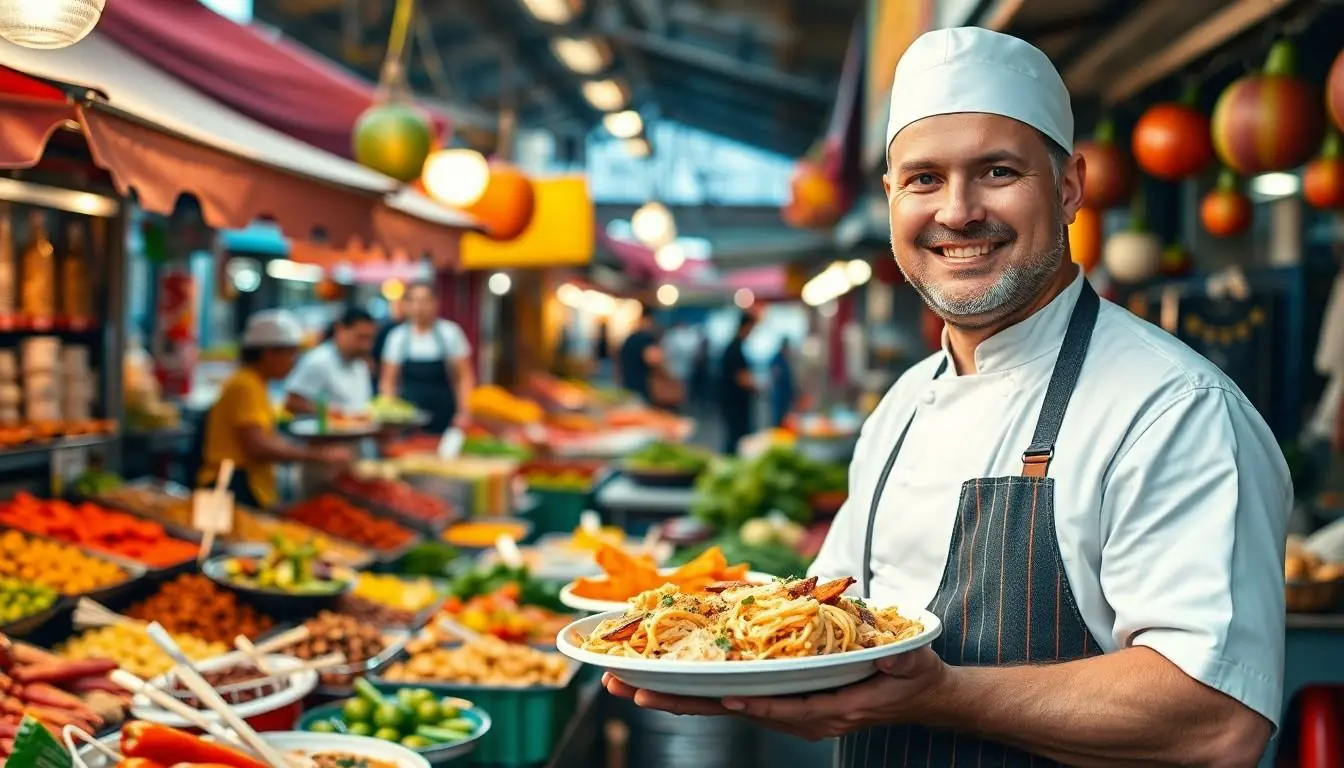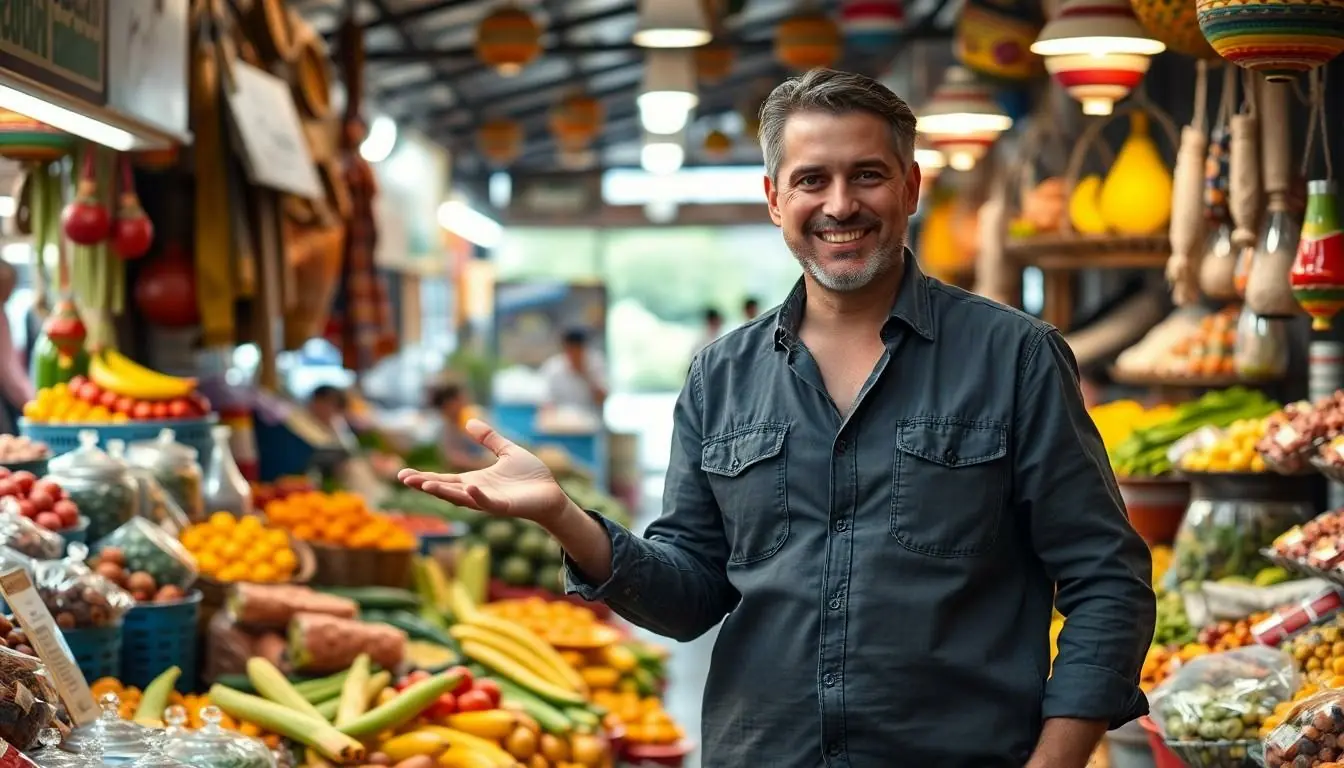Imagine savoring the mouthwatering flavors of street tacos in Mexico or indulging in the rich spices of an Indian curry—all from the comfort of your couch. Travel food shows do just that, whisking viewers away on a culinary adventure without the hassle of packing a suitcase or deciphering foreign menus. These shows are a delightful mix of travel, culture, and deliciousness that can make anyone’s taste buds dance.
From quirky hosts who charm their way through local eateries to stunning visuals that make food look like art, travel food shows are more than just entertainment. They inspire wanderlust and ignite curiosity about global cuisines. So grab your fork and get ready to explore the world one bite at a time. Whether you’re a seasoned foodie or just someone who loves to eat, there’s a flavor-packed journey waiting for you.
Table of Contents
ToggleOverview of Travel Food Show
Travel food shows serve as a window into the world’s culinary diversity. These programs highlight various cuisines, drawing viewers into unique cultural experiences. Engaging hosts guide audiences through markets, festivals, and kitchens, showcasing local traditions and flavors. Each episode captivates with vibrant visuals, transporting viewers to distant lands without leaving their living rooms.
In addition to showcasing food, travel food shows emphasize the stories behind each dish. Chefs often share personal anecdotes, shedding light on their heritage and inspirations. This storytelling aspect deepens the connection viewers feel to the cuisine. Finding new recipes becomes an exciting journey, inviting home cooks to experiment with global ingredients.
Various formats exist within these shows. Some focus on street food, while others explore high-end dining experiences. This variety caters to diverse tastes, ensuring that every viewer finds something enjoyable. Popular examples include “Anthony Bourdain: Parts Unknown,” which took audiences on a culinary voyage, and “No Reservations,” where food meets adventure.
Travel food shows also foster curiosity about international flavors. Viewers often find themselves eager to taste new dishes and recreate recipes at home. This enthusiasm drives culinary exploration, encouraging individuals to seek out local restaurants or markets that offer authentic cuisines. These shows inspire a desire to travel, pushing culinary enthusiasts to explore beyond their usual dining habits.
With food as a universal language, travel food shows connect people across cultures. By blending cuisine with travel, they create an immersive experience that transcends geographical borders, captivating audiences everywhere.
Popular Travel Food Shows

Travel food shows captivate audiences by revealing the rich tapestry of global cuisines. These programs immerse viewers in different cultures through food and exploration.
Show One Overview
“Anthony Bourdain: Parts Unknown” stands out for its raw and honest storytelling. This series delves into various destinations, showcasing local gourmet and everyday meals. Bourdain explores unique flavors, incorporating interviews with locals and chefs to enhance each experience. Audiences appreciate the show’s ability to mix travel, culture, and cuisine seamlessly. It encourages food lovers to expand their culinary horizons and reflect on the deeper connections between food and culture.
Show Two Overview
“Street Food” offers a glimpse into vibrant street food scenes worldwide. This series highlights the stories behind iconic dishes and the passionate vendors who prepare them. Each episode revolves around a different city, showcasing local specialties and culinary traditions. Viewers are drawn in by authentic street food experiences combined with personal narratives from the chefs. The focus on community and creativity turns casual food viewers into curious explorers.
Show Three Overview
“No Reservations” features dining adventures led by Anthony Bourdain. The series showcases diverse culinary landscapes, focusing on both high-end restaurants and local gems. Each episode brings a unique perspective on food, culture, and travel, with an emphasis on authenticity. Bourdain’s charismatic approach invites viewers to appreciate the art of cooking and the stories behind each meal. This blend of humor and insight cultivates a connection with a wide range of audiences, encouraging exploration of global flavors.
Impact on Culinary Tourism
Travel food shows significantly influence culinary tourism by fostering connections between cultures through shared culinary experiences. They inspire viewers to explore different destinations based on the foods highlighted.
Cultural Exchange Through Food
Culinary experiences create opportunities for cultural exchange. Food shows introduce audiences to local traditions, providing insights into the stories behind various dishes. Each episode showcases unique customs, fostering a deeper appreciation for global cultures. Viewers often develop a greater interest in traditional practices and rituals associated with specific dishes. By highlighting diverse cuisines, these shows promote a sense of community and unity among viewers, encouraging them to embrace cultural diversity.
Promotion of Local Cuisine
Local cuisines receive valuable exposure through travel food shows. Highlights of regional specialties create increased awareness among potential travelers. The focus on indigenous ingredients and cooking methods elevates unique dishes, prompting tourists to seek authentic culinary experiences. Well-presented stories of local chefs and food artisans inspire visitors to explore destinations beyond typical tourist attractions. As a result, culinary tourism thrives, benefiting local economies and preserving culinary heritage.
Viewer Engagement and Response
Travel food shows generate significant viewer engagement through relatable storytelling and immersive experiences. Audiences connect with programs tailored to showcase various cuisines and cultures.
Audience Demographics
Viewers of travel food shows encompass a diverse range of demographics. Adults aged 18 to 49 dominate the audience, representing over 60 percent of total viewership. This age group displays a strong interest in gastronomy, travel and cultural exploration. Additionally, family households frequently tune in, seeking entertainment that combines learning and leisure. Statistically, about 45 percent of viewers express an inclination to try new recipes after watching these shows. Engaging hosts and fascinating content keep these audiences coming back for more, continuously fueling curiosity.
Social Media Influence
Social media significantly amplifies viewer engagement with travel food shows. Platforms like Instagram and Facebook allow fans to share their thoughts and experiences, creating a vibrant community. Posts featuring colorful dishes and various culinary adventures boost visibility, encouraging more viewers to join in. Research indicates that 70 percent of audiences follow culinary-related accounts, increasing their likelihood of exploring new foods highlighted in these programs. Content sharing fosters discussion among fans, making food shows more interactive and relatable. Heightened interaction on social media strengthens viewer loyalty and expands the show’s reach to new demographics, enhancing the overall viewing experience.
Future Trends in Travel Food Shows
Emerging trends in travel food shows highlight a growing emphasis on sustainability. Producers increasingly focus on local sourcing practices that showcase farm-to-table experiences. Audiovisual storytelling also evolves, enriching narratives with interactive elements that engage viewers.
A surge in plant-based cuisine reflects changing dietary preferences. Shows now spotlight innovative vegetarian and vegan dishes, presenting diverse culinary options. Culinary host diversity broadens, introducing audiences to chefs from various backgrounds and cultures. This change enhances representation and allows for a richer exploration of global cuisines.
Technology integration becomes vital for enhancing viewer engagement. Virtual reality experiences provide immersive explorations of food cultures. E-commerce platforms may feature in-show purchasing options, enabling consumers to buy showcased ingredients or cookbooks directly.
Awareness of health and wellness influences programming. Many travel food shows now include segments on nutritious food choices, catering to an increasingly health-conscious audience. Documenting the impact of climate change on food systems also emerges as a prevalent theme. Shows address challenges such as sustainable fishing and farming practices, fostering greater public awareness.
Global collaboration is on the rise, as chefs and hosts engage in cross-border partnerships. Joint ventures showcase culinary diversity and exchange ideas among different cultures. Anticipating these evolving trends fosters a broader appreciation for food as a bridge connecting people worldwide.
Future travel food shows aim to inspire audiences through deeper cultural exploration. Engaging storytelling not only entertains but also encourages viewers to embark on their culinary journeys.
Travel food shows are more than just entertainment; they’re a gateway to the world’s culinary treasures. By blending food with culture and storytelling, these programs ignite curiosity and inspire viewers to explore new flavors. As audiences engage with diverse cuisines and local traditions, they foster a deeper appreciation for global cultures.
The future of travel food shows looks promising with a focus on sustainability and innovation. As producers embrace new technologies and diverse perspectives, viewers can expect even richer experiences. Whether viewers are seasoned foodies or casual watchers, these shows invite everyone to embark on a culinary adventure that transcends borders and unites people through the love of food.





